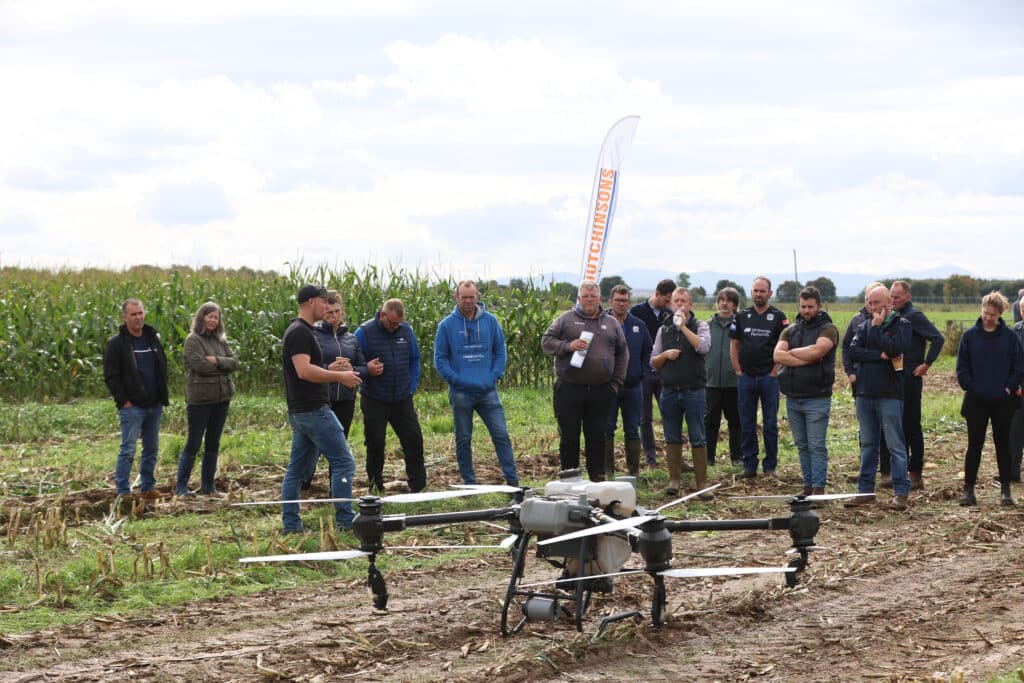Taking to the skies in trials to test novel maize management – British Dairying
Using a drone to undersow grass into a standing maize crop was just one of the fascinating talking points among growers at the Hutchinsons Maize Regional Technology Centre open day...
This year’s trials showcased various ways to help farmers maximise the output of maize grown under film and in open ground. Kindly hosted by the Fisher family at Smalmstown Farm near Carlisle, they included demonstrations of more than 20 new and existing varieties, placement fertilisers, and a novel use of a drone to aerially establish grass within a standing maize crop.
The decision to try undersowing with a drone came about because of the rapid crop growth seen earlier this spring, which made it difficult to get into fields to broadcast, or drill, grass seed before maize plants got too large.
“Drilling seed properly would generally still always give you the best results, but we’ve been really impressed with how well the drone has done,” says Hutchinsons Agronomist Jim Clark.
Two large (1.5ha) plots were undersown by agricultural drone contractor SAS Land Services, after herbicides had been applied at the beginning of June. One plot was sown a rate of 15kg/ha of grass seed, and another at 20kg/ha. A 75% Westerwold / 25% Italian ryegrass mix was used on both.
Flight plan
“The whole process was really easy, as we were able to export digital maps of the areas to be sown directly from Omnia to the drone operator, allowing them to easily create a flight plan,” explains Jim. “We found the downdraft from the drone’s propellers helped to blow the seed straight onto the ground. Seed was then reliant on having sufficient moisture to germinate, which fortunately we got, and the cover it has established is more than good enough.”
Finding ways to establish cover within maize – even when ground or crop conditions are more challenging – has become increasingly important given grazing requirements. The widespread adoption of stewardship schemes, like the sustainable farming incentive (SFI), plus new greening requirements for overwinter cover in Scotland are also factors, Jim adds. “We’ve also seen some milk processors introduce payments for having a cover crop on stubbles”.
Next year, Jim hopes to take the drone trials a step further, by using a drone to apply nutrition to the crop. “We want to see if this could be an effective back-up plan for applying vital nutrition in seasons when you can’t get onto the field with a tractor.”
Variety trials
The variety trials were another highlight of the Hutchinsons demonstration, with more than 20 varieties from eight different breeders put under the spotlight. “There’s quite a selection, with everything from very early maturing varieties, rated 150-160 [FAO maturity rating], to later maturing types nearer 190- 200,” notes Jim. “It was interesting to see that some varieties coped with the early dryness much better than others. However, we did notice a real turnaround once they received much-needed rain in June, with some backward crops overtaking those that had looked more promising earlier on.” All maize looked to have excellent potential this season, with some early yields coming in at 47-57t/ ha at 31-32% dry matter. “That’s almost unheard of around here, and I’m confident that maize, along with winter wheat, will be the stand-out crops in this area.”
Although 2025 has had a particularly dry season, compared to last year being one of the wettest, it appears that the same varieties performed best on-farm. “There is a variety to suit every situation, but you’ve got to pick the one that’s right for your soils, location, end use requirements, and planned drilling/ harvest dates,” he advises.
Placement fertiliser
Another trial at Smalmstown Farm examined the benefits of applying the placement fertiliser, Primary-P, with seed at drilling. The aim was to help support strong early root development and improve the crop’s ‘scavenging ability’ for water and nutrients throughout the season.
Three varieties were sown under film, and two in the open, each one replicated to compare varieties both with and without a placement fertiliser. “It was really interesting to see all plants that received the placement fertiliser were definitely greener, leafier, and had bigger, stronger stems, compared with the untreated,” says Jim. “It remains to be seen whether yield is massively different or not, but it certainly appeared to help the crop earlier in the season. We’ll yield map everything with the forager, so we should be able to see if there is a yield benefit, too.”
Future trials
More attention needs to be given to maize nutrition, as some crops are still being under-fed, he warns. And in dry years, like 2025, it can be particularly challenging for crops to take up enough nutrition from the soil. Leaf testing at the end of August confirmed some crops were ‘hungry’ for nitrogen and potash, largely due to the dry conditions.
In two other fields, where nitrogen had been applied as a foliar protected urea product, leaf testing confirmed noticeably higher nitrogen levels in the leaf than where crops had only received granular nitrogen. “It’s something we plan to look at in more detail next year, hopefully including the trials using a drone to apply foliar nutrition.”
Carlisle maize trials summary:
- Soil is predominantly sandy clay loam
- Fertile soils, pH 6.4
- Maize plots were ploughed, power harrowed, and drilled on May 7
- All plots sown at 103,800 seeds/ha
- Trial plots received pre-emergence dimethenamid-P plus pendimethalin
- Post-emergence mesotrione, nicosulfuron, and pyridate applications
- No seedbed fertiliser applied, but all plots received 40-50kg/ha of foliar N in late June
